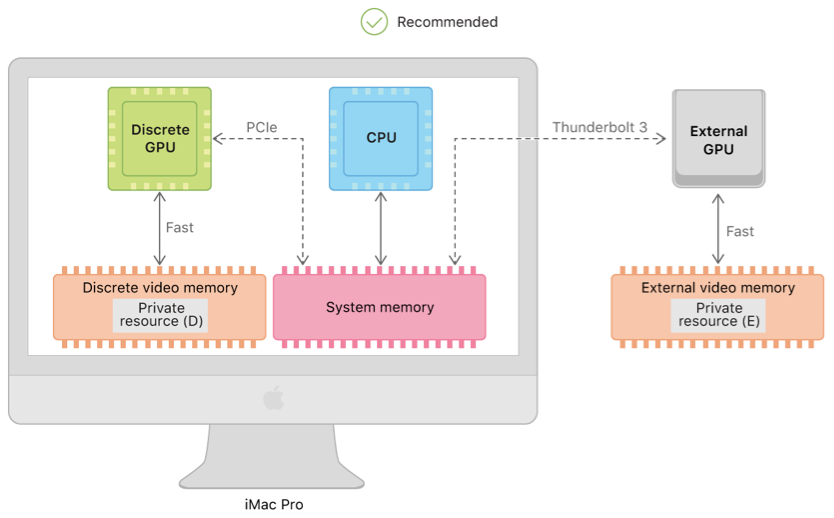手机Tiled-BasedRender和GPU带宽
带宽的概念
参考资料:
Bandwidth refers to the external bandwidth between a GPU and its associated system. It’s a measure of the data transfer speed across the bus that connects the two (for example, PCIe or Thunderbolt). Bandwidth doesn’t refer to the internal bandwidth of a GPU, which is a measure of the data transfer speed between components within the GPU.
内存一共有两种,设备内存和系统内存:
资源使用方式:
1.所有数据都放在系统内存

2.所有数据放到设备内存

3.同时放到设备系统内存

可以看到,经过PCIe访问的数据就会产生带宽。
渲染模式的推导
带宽和Cache导致了手机不得不使用Tiled Based Rendering。
立即模式的渲染Immediate-Mode Renderer (“IMR”)
如下图所示可以看到,每次读取数据,写出数据,都占用大量带宽。
IMR模式的渲染每次会有大量的栅格化写出,这部分内容是没有规律的。所以像素会反复写出。
这种状态下有一个Cache,是行级别的。

这里有一个极大的前提就是,Cache是有限的!!!
Tiled memory
第一个策略是把屏幕分块Cache,这样内存功能更加有规律。内存的传输不是太频繁了。

Rasterizing within tiles
上面的问题是,如果一个三角跨越整个屏幕的三角形会打破Cache。
进一步的优化,是基于Tiled进行光栅化:we can draw all the pixels that the triangle covers within one tile before moving on to the next tile.
Binning
进一步优化,我们现在不只是基于Cache去光栅化,而是直接基于Tiled计算所有的三角形。
- 第一步就是计算每个tile中的所有三角形。
Note that this process involves vertex shading, since this affects the location of triangles, but not fragment shading.

Tile-based rasterization
第二步就是基于Tile的栅格化。
Once the geometry has been sorted into bins, the rasterizer can process the scene one bin at a time, writing only to local tile memory until processing of the tile is finished.
由于一个一个处理所以Cache被压缩成了一个Tile,而不再需要多个Cache进行缓存了。
Since each tile is processed only once, the “cache” is now reduced to a single tile.
新的流程:
优点:
- Frame buffer memory bandwidth is greatly reduced, reducing power and increasing speed.
- Mobile memory is typically slower and lower power than desktop systems, and bandwidth is shared with the CPU, so access is very costly.
- With API support, off-chip memory requirements may also be reduced (it may not be necessary to allocate an off-chip Z buffer at all, for example).
- Texture cache performance can be improved (textures covering multiple primitives may be accessed more coherently one tile at a time than one primitive at a time.
- Much less on-chip space is needed for good performance compared with a general-purpose frame buffer cache.
- This means that more space can be dedicated to texture cache, further reducing bandwidth.
Limitations of tile-based rendering
While there are many performance advantages to tile-based rendering, there are some restrictions imposed by the technique:
- The two-stage binning and fragment passes introduce latency
- This latency should be hidden by pipelining and improved performance, but makes some operations relatively more costly
- In pipelined tiled rendering, framebuffer and textures required for rendering should be double-buffered so as to avoid stalling the pipeline。
- Framebuffer reads that might fall outside the current fragment are relatively more costly
- Operations such as screen-space ray tracing require writing all the framebuffer data - removing the ability to discard full-resolution images and depth values after use
- There is a cost to traversing the geometry repeatedly
- Scenes that are vertex-shader bound may have increased overhead in a tiler
- The binning pass may have limitations
- Some implementations may run out of space for binning primitives in very complex scenes, or may have optimizations that are bypassed by unusual input (such as highly irregular geometry)
- Switching to a different render target and back involves flushing all working data to memory and later reading it back
- For a tiler, it is especially important that shadow and environment maps be generated before the main frame buffer, not “on demand” during final rendering (though this is good advice for most GPUs)
- Graphics state (such as shaders) may change more frequently and less predictably
- Geometry that is “skipped” means that states do not necessarily follow in turn, making incremental state updates hard to implement
In most cases, the behavior of a tile-based GPU should not be appreciably worse than for an immediate-mode renderer using similarly limited hardware (indeed, some hardware can choose whether or not to run in a tiled mode), but it is possible to remove the performance benefits of tile-based rendering with the wrong use pattern.